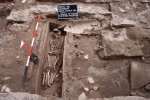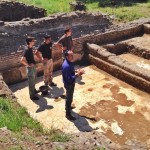 Excavations in Ostia, the ancient Roman harbour town at the mouth of the Tiber, have unearthed a group of more than 12 tombs from the 3rd-4th century A.D. Underscoring the cultural diversity of the port city, the necropolis includes inhumations and cremations, some right next to each other. The newly unearthed tombs are early Christian and surround a central tomb that belonged to someone of religious or social significance. The central tomb is a circular mausoleum lined in travertine that was originally built in the late Republican era and was reused in late antiquity. Archaeologists believe it may be an extended family unit who wanted to be buried at an important location, perhaps associated with one of the saints buried in early Christian Ostia.
Excavations in Ostia, the ancient Roman harbour town at the mouth of the Tiber, have unearthed a group of more than 12 tombs from the 3rd-4th century A.D. Underscoring the cultural diversity of the port city, the necropolis includes inhumations and cremations, some right next to each other. The newly unearthed tombs are early Christian and surround a central tomb that belonged to someone of religious or social significance. The central tomb is a circular mausoleum lined in travertine that was originally built in the late Republican era and was reused in late antiquity. Archaeologists believe it may be an extended family unit who wanted to be buried at an important location, perhaps associated with one of the saints buried in early Christian Ostia.
 The area being excavated, Parco dei Ravennati, was a suburb of the ancient city of Ostia on the left bank of the Tiber, now long since silted over. The area was used as a necropolis from the early imperial era through the 5th century when a basilica was built around the nearby tomb of 3rd century martyr Saint Aurea, patron saint of Ostia. The church was extensively renovated over the centuries; the current building was built by the Giuliano della Rovere, the future Pope Julius II, commissioner of Michelangelo’s Sistine Chapel frescoes, in the 15th century. Another important saint, Saint Monica, mother of Saint Augustine, died in Ostia in the late 4th century and was buried there. Her remains were moved to the Saint Aurea church in the 6th century before moving again to the Church of Saint Augustine in Rome.
The area being excavated, Parco dei Ravennati, was a suburb of the ancient city of Ostia on the left bank of the Tiber, now long since silted over. The area was used as a necropolis from the early imperial era through the 5th century when a basilica was built around the nearby tomb of 3rd century martyr Saint Aurea, patron saint of Ostia. The church was extensively renovated over the centuries; the current building was built by the Giuliano della Rovere, the future Pope Julius II, commissioner of Michelangelo’s Sistine Chapel frescoes, in the 15th century. Another important saint, Saint Monica, mother of Saint Augustine, died in Ostia in the late 4th century and was buried there. Her remains were moved to the Saint Aurea church in the 6th century before moving again to the Church of Saint Augustine in Rome.
There may be more information on the burials forthcoming courtesy of some inscriptions.
Additionally, several tombs had funerary inscriptions and archaeologists found a possible tabella defixionum, a lead curse tablet intended to protect the dead and bring anathema to tomb desecrators.
“They were really horrible curses to protect the dead”, Paola Germoni, head of Ostia’s archaeological superintendency, added.
Studies remain ongoing, according to Michele Raddi, excavation co-director, who said “we found a number of fragmentary inscriptions in the tombs as well as a possible tabella defixionum, but we need to evaluate its context and see if it has an inscription”.
 Parco dei Ravennati wasn’t just a necropolis, however. Multiple domestic spaces have been unearthed, including an elaborate opus sectile marble inlay floor from the late 4th century. This season’s excavations have found even more of that aristocratic home, a space adjacent to the opus sectile room that was paved with paving stones and converted to commercial use. The discovery of hooks and lead weights from fishing nets suggest the elegant home was re-purposed for fish processing in the early Middle Ages. Ancient sources and earlier archaeology pointed to Ostia being in steep decline as a commercial center starting in the reign of Constantine I (306-337 A.D.), so the discovery of active businesses from the early Middle Ages is going to change what we know about Ostia.
Parco dei Ravennati wasn’t just a necropolis, however. Multiple domestic spaces have been unearthed, including an elaborate opus sectile marble inlay floor from the late 4th century. This season’s excavations have found even more of that aristocratic home, a space adjacent to the opus sectile room that was paved with paving stones and converted to commercial use. The discovery of hooks and lead weights from fishing nets suggest the elegant home was re-purposed for fish processing in the early Middle Ages. Ancient sources and earlier archaeology pointed to Ostia being in steep decline as a commercial center starting in the reign of Constantine I (306-337 A.D.), so the discovery of active businesses from the early Middle Ages is going to change what we know about Ostia.
“What’s amazing is that you have continual use in this park straight through from republic and imperial times through to the Middle Ages and the Renaissance, its giving us precious information about the later periods and how it relates to Ostia Antica”, [director of the American Institute for Roman Culture Darius] Arya said.
“The discoveries in the Parco dei Ravennati underlines the extraordinary continuity of life and activity along the Tiber River banks, in Ostia Antica’s suburbs”